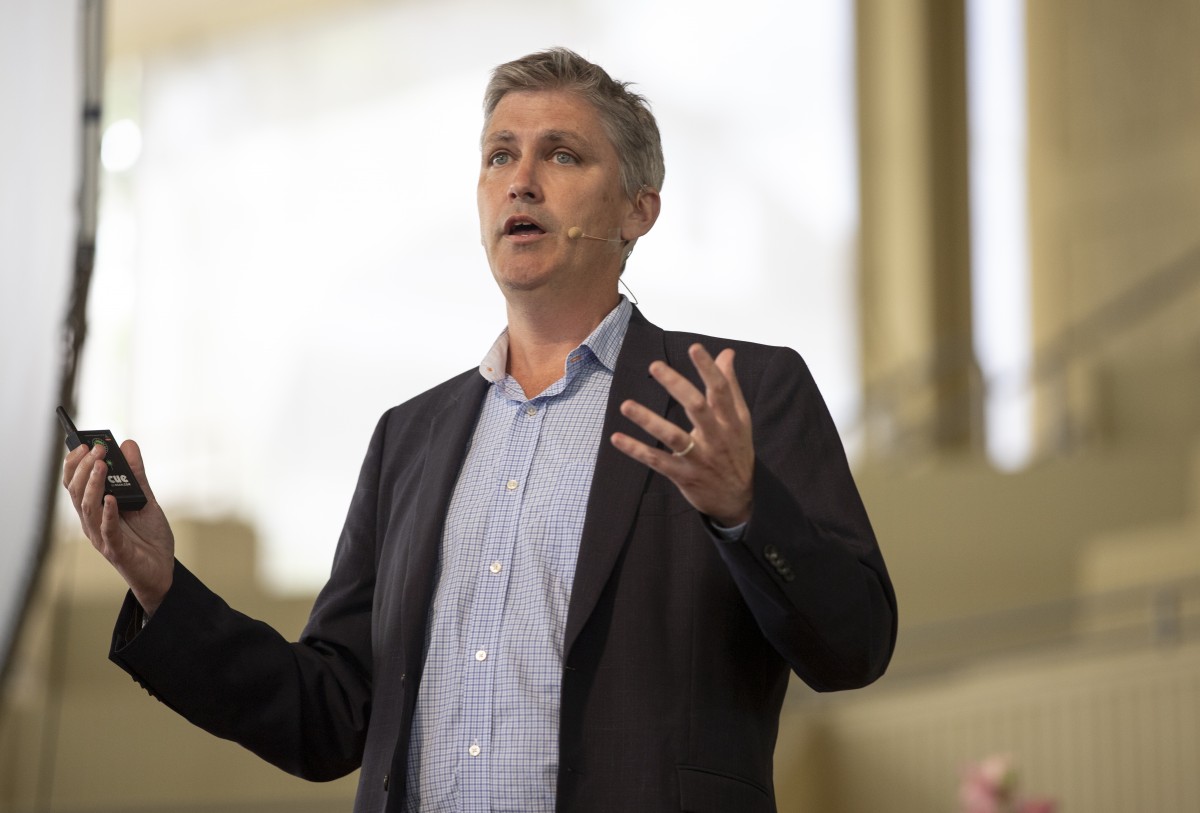The future lies wherever people are having the most fun, author Steven Johnson said at the 10:45 a.m. morning lecture Tuesday, July 10, in the Amphitheater, playing on Week Three’s theme, “The Art of Play.”
For Johnson, it is impossible to tell the accurate history of modern inventions without the origins of fun — a theme he argues extensively in his book Wonderland: How Play Made the Modern World. Wonderland is Johnson’s 11th book, all of which explore innovation and innovators.
“I set out to tell (the history of fun) and after a couple of years of research, I began to realize … that all of these activities that I had undertaken for no apparent purpose other than that they seem interesting and provocative and fun, to a surprising extent ending up leading to transformative ideas in the serious, utilitarian world,” he said.
Johnson’s journey to this realization started in early 19th-century London, where magic lantern shows, 360-degree panoramas and haunted houses decked out with electric shock machines made for “fun” in the city’s West End. Tucked on a side street, adjacent to Hanover Square, sat the peculiar Merlin’s Mechanical Museum.
John Joseph Merlin, a clockmaker and “tinkerer” famous for his love of automaton creations and the invention of roller skates, opened the museum in the 1700s to display his realistic, self-operating automaton dolls and animals. Those creations, especially an animated dancer, mesmerized a young 8-year- old Charles Babbage.
However, Merlin wasn’t the first to replicate life through machines — Johnson’s journey through the history of fun took him back nearly 1,000 years to the House of Wisdom in Baghdad, Iraq. The House of Wisdom was an intellectual hub whose students included three brothers who later published The Book of Ingenious Devices in 850 A.D..
Their book featured primitive designs for early automatons, clocks, float valves and other engineering marvels that would become crucial to the modern world, according to Johnson.
“The other thing that’s intriguing about The Book of Ingenious Devices, as you flip through its pages, is that almost every device in the book is, in one fashion or another, a toy,” he said.
The toys range from “animated peacocks, where you pull a feather and a little man appears and gives you a bar of soap,” to moving elephants, or a boat of “a bunch of musicians that play tunes in the boat as it’s rocking back in forth in the waves.”
“None of it is functional or utilitarian in any way,” Johnson said. “So you have this very interesting combination of some of the most advanced engineering in the world dedicated entirely to what seems like child’s play — what seems like toys and games.”
Frenchman Jacques de Vaucanson took inspiration from these “toyish” designs to create the “digesting duck,” also known as the “defecating duck,” an extremely life-like automaton that could be fed (and expel) pellets; Johnson described this contraption as “the PlayStation of the 1730s.”
Aside from his work with automatons, Vaucanson also conceptualized an early weaving device. Unfortunately, his version was awed; the material was too expensive, and it could only produce a limited amount of fabric. However, fellow Frenchman Joseph Marie Jacquard took over the project and created what would eventually become known was the “Jacquard Loom.”
The new-and-improved loom replaced the once-expensive materials with punched paper cards, which were easy to reproduce and created endless weaving patterns.
Jacquard’s punched card system caught the attention of English inventor Charles Babbage, who decades earlier had visited Merlin’s Mechanical Museum, and was awed by the automatons.
“He became increasingly obsessed with the idea that machines could perform life-like functions, initially movement, but then cognition, thinking, calculation, computation, and that’s what led him to the ‘difference engine’ and ‘analytical engine,’ ” John- son said.
Babbage took the punched cards to create the first version of the computer.
“Babbage’s ideas were way ahead of their time; the machines never fully worked. They became the key ingredients for modern computers, the idea of software and hardware, the idea of memory and storage, the idea of central-processing units,” Johnson said. “He was effectively trying to build a digital age machine in the age of stream power.”
While Babbage was making strides in technology, his colleague Ada Lovelace was making strides for women in computer science, even before computer science was a career. Lovelace was a “math wiz” and created the first code for Babbage’s computer. She saw computers as more than instruments for math and computing, but as instruments for fun.
Johnson said that traditionally, the birth of the computer is thought of as a result of “serious history,” like the Manhattan Project, space exploration or cracking the Enigma, but the greatest inventions evolved from fun.
“You cannot tell the history of the computer and not also include the history of a boy who saw an animated dancer at a mechanical museum and a bunch of engineers in Baghdad trying to create an automatic flute player and a defecating duck,” he said. “Those are key participants in the story as well.”
This untold history continues into the 1960s at the Massachusetts Institute of Technology, when the arrival of a new computer, equipped with a screen, inspired the first video game, “Spacewar.”
“You could make the argument that it was one of the most important works of programming during the entire 1960s in part … because of the idea it presented — the idea that Ada Lovelace first conceived more than a century ago that computers were going to be fun,” Johnson said. “They weren’t just going to be for big business or big government. The people were going to have a playful relationship with their screens.”
And this history continues again into the 1970s, when Stewart Brand, after seeing the success of “Spacewar,” said in Rolling Stone magazine, “ready or not, computers are coming to the people,” coining the term “personal computers.”
And again the untold history continued years later, when a young Steve Jobs took inspiration from Brand to create the first Macintosh personal computer.
“So again, you cannot tell the story of the digital revolution and iPhones, and Android phones and the internet, without including the story of ‘Spacewar,’ ” Johnson said. “It has a direct influence on those (inventors’) lives. So that is one arc that shows how technology that we think of as transformative and serious comes out of that playful exploration at the margins.”
In Johnson’s book, Wonderland, he argues that there is a perpetual need for playful spaces like 1800s coffee houses, which he references in four of his other books. He stressed that major cultural shifts, like the Enlightenment, happened in coffee houses, not across borders. (Charles II actually outlawed coffee houses because they took people away from their “actual, lawful calling and affairs.” That ban lasted one week.)
According to Johnson, coffee houses were important in the 19th century for two reasons: the first, to wean people off of alcohol.
“You would wake up in the morning, you’d drink beer for breakfast, you’d drink beer at work, you’d drink wine with lunch. … That whole period was a steady background state of inebriation. They were kind of drunk all day long,” he said. “(When) the population switched (from) drinking a depressant all day long to a drinking a simulatant all day long, hey, no surprise, there was this great flowering of industrial, intellectual activity.”
The second, more important reason was that coffee houses created a space for interdisciplinary thought, where great minds could converse and imagine the next revolutionary idea, which is something Johnson sees reflected in Chautauqua Institution.
“We are all coming together, taking time out from our ‘actual, lawful calling and affairs’ to immerse ourselves in different ideas and surprising ideas and to listen to people with different points of view and different perspectives and different expertise,” he said.
He left the audience with one final thought about where the history of play is taking the future: predicting innovation does not come from higher levels of government or universities — “it was the defecating duck, it was the contraptions in Merlin’s Mechanical Museum; … that’s what Babbage was able to see in that moment in the animated dancer.”
“And so what happens in the margins of society, in these playful accounts that sometimes just seem like they have no purpose, actually is often the seedlings of big changes that are coming,” Johnson said. “So when you look out at the world today and you see people doing seemingly trivial things that look useless but also seem to be captivating and fun, … pay attention because something important is brewing there.”
After the conclusion of his lecture, Chautauqua Institution Chief of Staff Matt Ewalt opened the Q-and-A. Ewalt asked how play is being incorporated into modern-day workplaces.
Johnson said that copying and pasting Google’s methods doesn’t work for every company.
“Dropping in a foosball table … isn’t going to change (the work environment),” he said. “But what you want to find is the creative side or playful side of your organization, that is actually indigenous to your organization, that’s part of the culture.”
One attendee asked what “fringe activities” Johnson is seeing going on now that are going to change the future.
“Pokemon Go,” Johnson answered.





